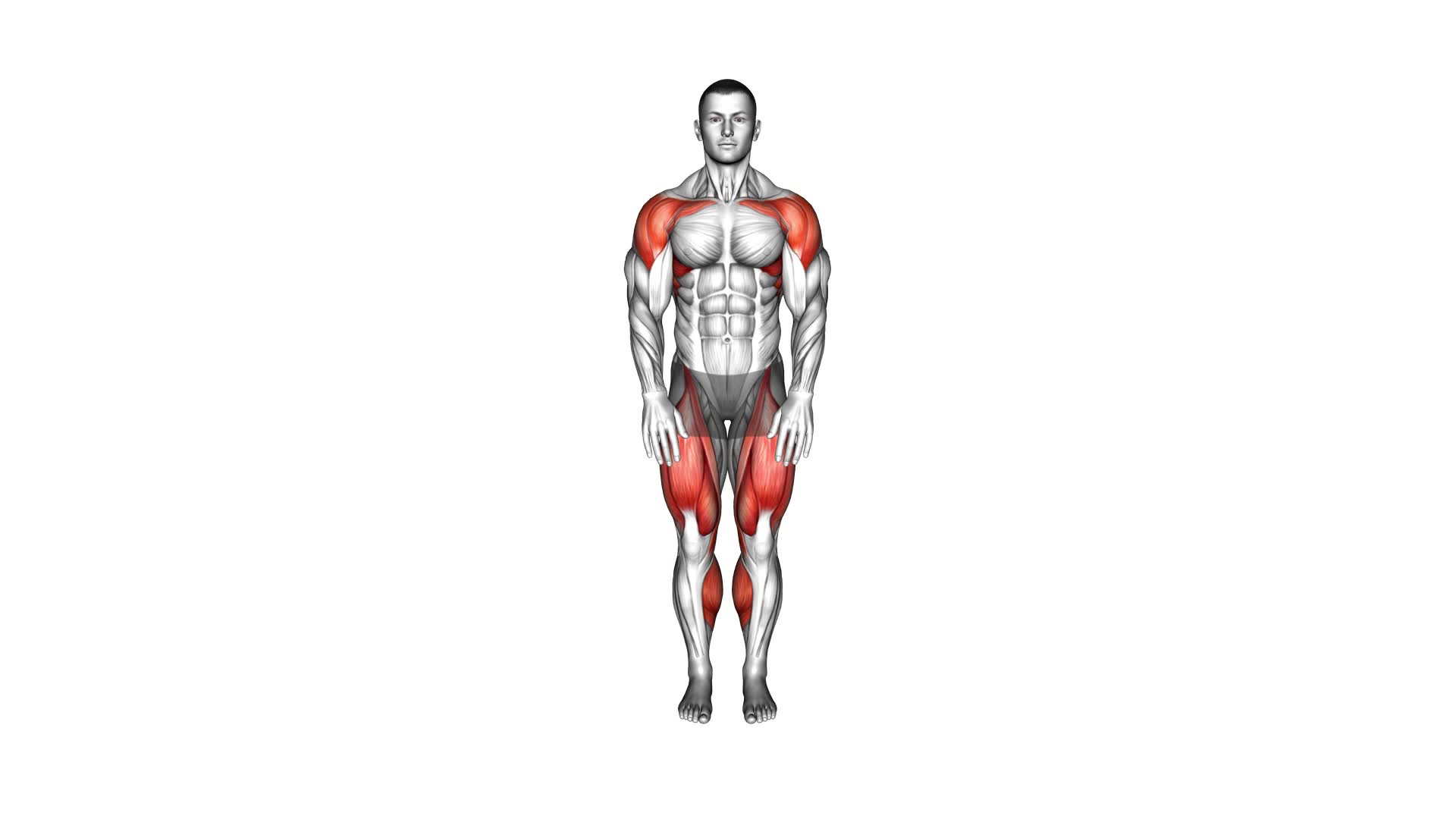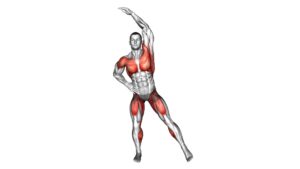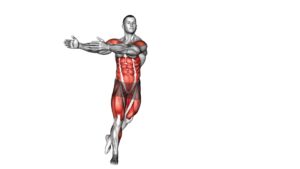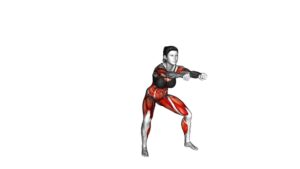Swing and Froward Step (male) – Video Exercise Guide & Tips

Get ready to level up your fitness routine with the Swing and Forward Step exercise! In this video exercise guide, we'll show you how to perform this dynamic move that targets your entire body.
Watch This Exercise Video
Whether you're a beginner looking to enhance your strength or an advanced athlete seeking a challenge, we've got you covered. Follow along as we provide step-by-step instructions, common mistakes to avoid, and helpful tips for maximizing your results.
Let's get started and amp up your workout game!
Key Takeaways
- The swing and forward step exercise improves balance, core strength, and stability.
- It targets and strengthens core muscles, as well as glutes, hamstrings, and quads for lower body toning and strengthening.
- Proper equipment, such as a kettlebell or dumbbell, mat or cushion, athletic shoes, and wrist wraps or gloves, is needed for this exercise.
- Beginners can start with lighter weights and focus on mastering proper form, while advanced levels can increase weight, incorporate explosive movements, and explore advanced variations.
Benefits of the Swing and Forward Step Exercise
You will experience significant improvements in your balance and core strength by regularly performing the Swing and Forward Step exercise. This exercise offers a multitude of benefits for your overall fitness and well-being. Firstly, it targets and strengthens your core muscles, including your abdominals, obliques, and lower back. By engaging these muscles, you can enhance your stability and balance, which is crucial for everyday activities and sports performance.
Additionally, the Swing and Forward Step exercise also works your glutes, hamstrings, and quads, helping to tone and strengthen your lower body.
The technique for the Swing and Forward Step exercise is relatively simple. Start by standing with your feet hip-width apart, holding a dumbbell or kettlebell in front of you with both hands. Begin the exercise by swinging the weight between your legs, then explosively drive your hips forward as you swing the weight up to shoulder height. At the same time, take a large step forward with your opposite leg, maintaining a strong and stable core. Return to the starting position and repeat on the other side. Remember to engage your core muscles throughout the movement and focus on maintaining proper form.
Equipment Needed for the Exercise
To effectively perform the Swing and Forward Step exercise, there are essential pieces of exercise equipment you'll need, such as a kettlebell or dumbbell. Additionally, recommended exercise accessories include a mat or cushion for comfort and stability.
If you're a beginner, there are equipment alternatives available that can help you ease into the exercise and build strength gradually.
Essential Exercise Equipment
To perform the Swing and Forward Step exercise, you'll need a set of dumbbells. Dumbbells are an essential piece of exercise equipment that can help you build strength and improve your overall fitness. They're versatile and can be used for a wide range of exercises targeting different muscle groups.
When choosing dumbbells, it's important to select a weight that challenges you but is still manageable for proper form and technique. Investing in a set of adjustable dumbbells allows you to increase or decrease the weight as needed.
Dumbbells are considered one of the workout essentials and should be included in your exercise gear collection. They provide a convenient and effective way to add resistance to your workouts, helping you reach your fitness goals.
Recommended Exercise Accessories
To perform the Swing and Forward Step exercise, you'll need a pair of dumbbells. In addition to dumbbells, there are a few other exercise accessories that can enhance your workout and help you achieve better results.
One such accessory is a kettlebell, which can be used to add resistance and intensity to your swings.
A fitness mat or cushioned flooring is recommended to provide comfort and support during the forward step portion of the exercise.
Wearing proper athletic shoes with good stability and cushioning is also important to prevent any foot or ankle injuries.
Additionally, using wrist wraps or gloves can provide extra grip and support while holding the dumbbells.
These exercise tools and fitness gear will help you perform the Swing and Forward Step exercise effectively and safely.
Equipment Alternatives for Beginners?
If you're a beginner, you'll only need a pair of dumbbells to perform the Swing and Forward Step exercise. This exercise doesn't require any specific equipment, making it accessible for beginners who may not have access to a full gym setup.
Dumbbells are a versatile piece of equipment that can be easily adjusted to accommodate different fitness levels. They provide the resistance needed to challenge your muscles and promote strength development. As you progress and become more comfortable with the exercise, you can explore different variations by using heavier dumbbells or incorporating kettlebells. These equipment options can add an extra challenge to the exercise and help you continue to progress in your fitness journey.
Now that you know what equipment you need, let's move on to discussing the proper technique for the swing and forward step.
Proper Technique for the Swing and Forward Step
Master the proper technique for the Swing and Forward Step to maximize your workout results. To ensure you're getting the most out of this exercise, it's crucial to avoid common mistakes and focus on maximizing your results.
First, start by standing with your feet shoulder-width apart and your knees slightly bent. Hold a kettlebell or dumbbell with both hands in front of your body, keeping your arms straight. Engage your core and maintain a neutral spine throughout the movement.
To begin the swing, hinge at your hips and allow the weight to swing back between your legs. Remember to keep your back straight and avoid rounding your shoulders. As you swing the weight forward, generate power from your hips and squeeze your glutes at the top of the movement.
Now, let's move on to the forward step. From the top of the swing, take a big step forward with one foot, lowering your body into a lunge position. Keep your front knee directly above your ankle and your back knee hovering just above the ground. Push off with your front foot and return to the starting position, repeating the movement on the opposite side.
By mastering the proper technique for the Swing and Forward Step, you can maximize your workout results and avoid common mistakes. Remember to focus on proper form, engage your core, and use your hips to generate power.
Incorporate this exercise into your routine for a challenging full-body workout.
Common Mistakes to Avoid
Avoid these three common mistakes to get the most out of your Swing and Forward Step exercise. Proper technique is essential for maximizing the benefits of this exercise.
The first common mistake to avoid is using excessive momentum. It's important to maintain control throughout the movement and not rely solely on momentum to swing your leg forward. By focusing on engaging your muscles and using controlled movements, you'll challenge your muscles more effectively.
The second common mistake is neglecting your posture. It's crucial to maintain a tall and upright posture throughout the exercise. Avoid slouching or leaning forward, as this can put unnecessary strain on your lower back. By keeping your spine aligned and your core engaged, you'll enhance the effectiveness of the exercise and protect your back from injury.
Lastly, be mindful of your foot placement. Placing too much weight on your toes or heels can lead to imbalances and improper form. Aim to distribute your weight evenly on both feet, with the majority of the weight on the balls of your feet. This will help you maintain stability and engage the correct muscles.
Modifications for Beginners and Advanced Levels
Now let's talk about how to modify the Swing and Forward Step exercise for different levels of experience.
If you're a beginner, there are some tips you can follow to make the exercise more manageable and avoid injury.
On the other hand, if you're advanced, there are modifications you can incorporate to challenge yourself and continue progressing.
Let's explore these modifications in detail to help you get the most out of your workout.
Beginner Modification Tips
To modify this exercise for beginners and advanced levels, try incorporating a few simple adjustments.
For beginners:
- Focus on proper form and technique to prevent injuries.
- Start by using lighter weights or no weights at all until you feel comfortable with the movement.
- Slow down the pace of the exercise to ensure control and stability.
- Reduce the range of motion to make it more manageable.
- Listen to your body and not push beyond your limits.
- Remember to warm up before starting the exercise and cool down afterwards to prevent muscle soreness.
- Consult with a healthcare professional before attempting this or any exercise if you have any underlying medical conditions or concerns.
For advanced levels:
- Continue to prioritize proper form and technique.
- Gradually increase the weight used for the exercise as you become stronger and more comfortable.
- Maintain a controlled pace, ensuring that you have control throughout the entire range of motion.
- Consider increasing the range of motion to challenge yourself further.
- Push yourself to reach your limits, but still listen to your body and avoid overexertion or potential injury.
- Warm up before starting the exercise and cool down afterwards to prevent muscle soreness.
- As always, consult with a healthcare professional before attempting this or any exercise if you have any underlying medical conditions or concerns.
Advanced Level Modifications
To advance the exercise and challenge yourself further, incorporate these modifications for both beginners and advanced levels.
For the advanced level modifications, you can try adding weights to increase the resistance and intensity. Holding a dumbbell or kettlebell in your hands while performing the swing and forward step will engage your muscles even more.
Another option is to increase the height of your step or use an unstable surface like a balance board to challenge your balance and stability.
Additionally, you can incorporate plyometric movements such as jumping or explosively stepping forward to further enhance the difficulty of the exercise.
These progression options will take your workout to the next level and help you continue to improve your strength, stability, and coordination.
Tips for Maximizing Your Results
To optimize your results, focus on incorporating proper form and increasing the intensity of your swings and forward steps. Here are three tips to help you maximize your intensity and increase your endurance:
- Engage your core: During the swings and forward steps, make sure to engage your abdominal muscles. This won't only help you maintain proper form but also increase the intensity of the exercise. Keep your core tight and stable throughout the movement.
- Gradually increase weight and speed: As you become more comfortable with the swings and forward steps, challenge yourself by gradually increasing the weight and speed of the movements. This will push your muscles to work harder and improve your endurance over time.
- Incorporate interval training: To further maximize your results, consider incorporating interval training into your routine. Alternate between periods of high-intensity swings and forward steps with periods of rest or lower intensity exercises. This will help improve your cardiovascular fitness and overall endurance.
Frequently Asked Questions
How Many Calories Can I Expect to Burn With the Swing and Forward Step Exercise?
You can expect to burn a significant amount of calories with the swing and forward step exercise. The exact number of calories burned will depend on various factors such as your weight, intensity, and duration of the workout.
To maximize calorie burn, it's recommended to perform this exercise regularly and incorporate it into your workout routine. Consistency is key when it comes to achieving your fitness goals.
How Often Should I Incorporate the Swing and Forward Step Exercise Into My Workout Routine?
To incorporate the swing and forward step exercise into your workout routine, it's recommended to do it 2-3 times a week. This frequency allows for proper muscle recovery and prevents overtraining.
Adding this exercise to your routine offers several benefits, including improved cardiovascular endurance, increased lower body strength, and enhanced balance and coordination.
However, make sure to follow proper form and listen to your body to avoid any potential injuries.
Can the Swing and Forward Step Exercise Help Improve Balance and Coordination?
Improving balance and coordination is a common goal for many people. One exercise that can help you achieve this is the swing and forward step exercise. This exercise focuses on engaging your core muscles and challenging your stability.
By incorporating variations and modifications, you can tailor the exercise to your fitness level and target specific areas of improvement.
Regularly including this exercise in your workout routine can be beneficial for improving flexibility, balance, and coordination.
Is the Swing and Forward Step Exercise Suitable for Individuals With Knee or Hip Injuries?
The swing and forward step exercise may not be suitable for individuals with knee or hip injuries. It puts strain on those joints, potentially causing further damage. If you have such injuries, it's important to consult with a healthcare professional before attempting this exercise. Modifications or alternatives can be suggested by a physical therapist or trainer, based on your specific needs.
If you don't have the necessary equipment, there are other exercises that can target similar muscle groups.
Are There Any Alternative Exercises That Can Be Done if I Don't Have the Necessary Equipment for the Swing and Forward Step Exercise?
If you don't have the necessary equipment for the swing and forward step exercise, there are alternative exercise options you can try. You can consider exercises like lunges, step-ups, or even walking/jogging to achieve similar benefits.
These exercises can help strengthen your lower body and improve cardiovascular fitness.
Additionally, if you have any knee or hip injuries, you can modify the swing and forward step exercise by reducing the range of motion or using a lower step height to avoid any discomfort or pain.
Conclusion
In conclusion, the swing and forward step exercise is an effective way to improve strength and stability in the lower body. By incorporating this exercise into your routine, you can enhance your balance and coordination while targeting key muscle groups.
Remember to use proper technique and avoid common mistakes to maximize your results. Whether you're a beginner or at an advanced level, modifications can be made to suit your fitness level.
Keep pushing yourself and strive for progress with this dynamic exercise.

Author
Years ago, the spark of my life’s passion ignited in my mind the moment I stepped into the local gym for the first time. The inaugural bead of perspiration, the initial endeavor, the very first surge of endorphins, and a sense of pride that washed over me post-workout marked the beginning of my deep-seated interest in strength sports, fitness, and sports nutrition. This very curiosity blossomed rapidly into a profound fascination, propelling me to earn a Master’s degree in Physical Education from the Academy of Physical Education in Krakow, followed by a Sports Manager diploma from the Jagiellonian University. My journey of growth led me to gain more specialized qualifications, such as being a certified personal trainer with a focus on sports dietetics, a lifeguard, and an instructor for wellness and corrective gymnastics. Theoretical knowledge paired seamlessly with practical experience, reinforcing my belief that the transformation of individuals under my guidance was also a reflection of my personal growth. This belief holds true even today. Each day, I strive to push the boundaries and explore new realms. These realms gently elevate me to greater heights. The unique combination of passion for my field and the continuous quest for growth fuels my drive to break new ground.







